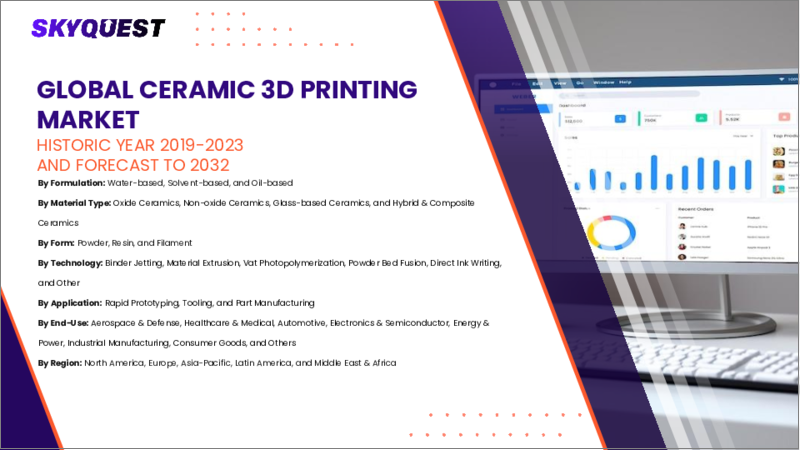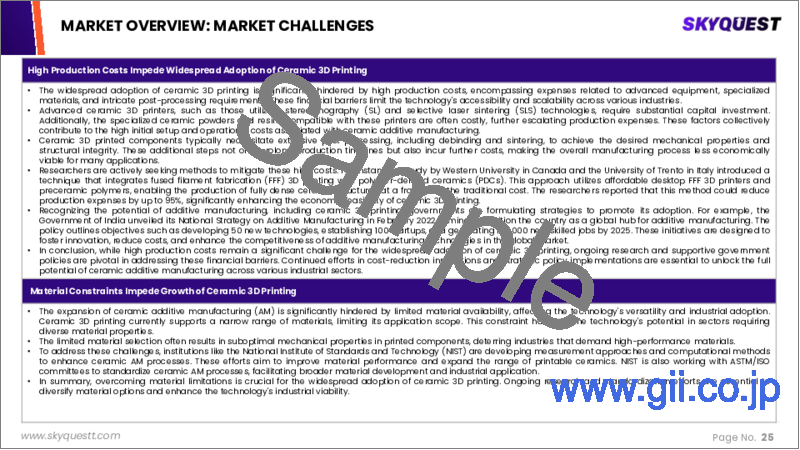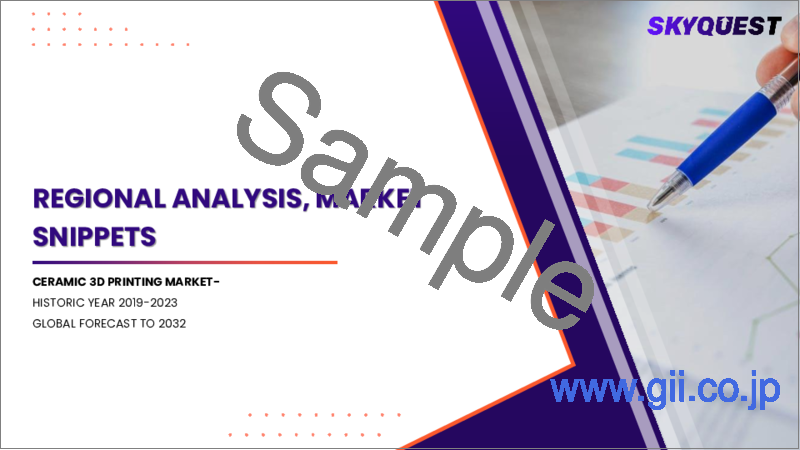|
|
市場調査レポート
商品コード
1654012
セラミック3Dプリントの市場規模、シェア、成長分析:配合別、タイプ別、形態別、技術別、用途別、最終用途別、地域別 - 産業予測、2025年~2032年Ceramic 3D Printing Market Size, Share, and Growth Analysis, By Formulation (Water-based, Solvent-based), By Type (Functional, Decorative), By Form, By Technology, By Application, By End-Use, By Region - Industry Forecast 2025-2032 |
||||||
|
|||||||
| セラミック3Dプリントの市場規模、シェア、成長分析:配合別、タイプ別、形態別、技術別、用途別、最終用途別、地域別 - 産業予測、2025年~2032年 |
|
出版日: 2025年02月09日
発行: SkyQuest
ページ情報: 英文 157 Pages
納期: 3~5営業日
|
全表示
- 概要
- 目次
セラミック3Dプリントの世界市場規模は、2023年に2億3,636万米ドルと評価され、2024年の2億9,970万米ドルから2032年には20億284万米ドルに成長し、予測期間(2025年~2032年)のCAGRは26.8%で成長する見通しです。
世界のセラミック3Dプリント市場は、製造技術の進歩や多様な産業におけるカスタマイズされたセラミック部品への需要の高まりに後押しされ、大きな成長を遂げています。積層造形またはステレオリソグラフィとしても知られるこの技術は、複雑なセラミック構造を精密に作成することを可能にし、設計の柔軟性と材料特性を向上させます。主な成長促進要因としては、航空宇宙、ヘルスケア、自動車、電子機器、エネルギーなどの産業におけるセラミックの使用拡大が挙げられます。タービンブレードや歯科インプラントのような軽量で高性能な部品を製造する能力が、採用を加速しています。さらに、持続可能性に重点を置くセラミック部門は、3Dプリンティングをより環境に優しい選択肢として位置づけ、従来の方法と比較して材料廃棄物やエネルギー使用を削減し、環境責任を重視する世界の動きを支えています。
目次
イントロダクション
- 調査の目的
- 調査範囲
- 定義
調査手法
- 情報調達
- 二次と一次データの方法
- 市場規模予測
- 市場の前提条件と制限
エグゼクティブサマリー
- 世界市場の見通し
- 供給と需要の動向分析
- セグメント別の機会分析
市場力学と見通し
- 市場概要
- 市場規模
- 市場力学
- 促進要因と機会
- 抑制要因と課題
- ポーターの分析
主な市場の考察
- 主要成功要因
- 競合の程度
- 主な投資機会
- 市場エコシステム
- 市場の魅力指数(2024年)
- PESTEL分析
- マクロ経済指標
- バリューチェーン分析
- 価格分析
セラミック3Dプリントの市場規模:配合別 & CAGR(2025年~2032年)
- 市場概要
- 水性
- 溶剤ベース
- 油性
セラミック3Dプリントの市場規模:タイプ別 & CAGR(2025年~2032年)
- 市場概要
- 機能的
- 装飾的
セラミック3Dプリントの市場規模:形態別 & CAGR(2025年~2032年)
- 市場概要
- 粉
- 樹脂
- フィラメント
セラミック3Dプリントの市場規模:技術別 & CAGR(2025年~2032年)
- 市場概要
- デジタル印刷
- アナログ印刷
セラミック3Dプリントの市場規模:用途別 & CAGR(2025年~2032年)
- 市場概要
- ラピッドプロトタイピング
- ツーリング
- 部品製造
セラミック3Dプリントの市場規模:最終用途別 & CAGR(2025年~2032年)
- 市場概要
- ヘルスケア
- 航空宇宙および防衛
- 自動車
- その他
セラミック3Dプリントの市場規模 & CAGR(2025年~2032年)
- 北米
- 米国
- カナダ
- 欧州
- ドイツ
- スペイン
- フランス
- 英国
- イタリア
- その他欧州
- アジア太平洋
- 中国
- インド
- 日本
- 韓国
- その他アジア太平洋
- ラテンアメリカ
- ブラジル
- その他ラテンアメリカ
- 中東・アフリカ
- GCC諸国
- 南アフリカ
- その他中東・アフリカ
競合情報
- 上位5社の比較
- 主要企業の市場ポジショニング(2024年)
- 主な市場企業が採用した戦略
- 最近の市場動向
- 企業の市場シェア分析(2024年)
- 主要企業の企業プロファイル
- 企業の詳細
- 製品ポートフォリオ分析
- 企業のセグメント別シェア分析
- 収益の前年比比較(2022年~2024年)
主要企業プロファイル
- 3D Systems Corporation(米国)
- Materialise NV(ベルギー)
- Renishaw plc(英国)
- Autodesk, Inc.(米国)
- HP Inc.(米国)
- Proto Labs, Inc.(米国)
- Nano Dimension Ltd.(イスラエル)
- Altair Engineering Inc.(米国)
- Dassault Systemes SE(フランス)
- General Electric Company(米国)
- L3Harris Technologies, Inc.(米国)
- PPG Industries, Inc.(米国)
- Tethon 3D(米国)
- 3DCeram S.A.(フランス)
- Lithoz GmbH(オーストリア)
- XYZprinting(台湾)
- ExOne Company(米国)
- Voxeljet AG(Germany)
- Organovo Holdings, Inc.(米国)
結論と提言
Global Ceramic 3D Printing Market size was valued at USD 236.36 million in 2023 and is poised to grow from USD 299.7 million in 2024 to USD 2002.84 million by 2032, growing at a CAGR of 26.8% during the forecast period (2025-2032).
The global ceramic 3D printing market has experienced significant growth fueled by advancements in manufacturing technologies and the rising demand for customized ceramic components across diverse industries. This technique, also known as additive manufacturing or stereolithography, allows for the precise creation of intricate ceramic structures, enhancing design flexibility and material properties. Key growth drivers include the expanding use of ceramics in industries such as aerospace, healthcare, automotive, electronics, and energy. The ability to produce lightweight, high-performance components-like turbine blades and dental implants-has accelerated adoption. Additionally, the ceramics sector's focus on sustainability has positioned 3D printing as a greener alternative, reducing material waste and energy use compared to traditional methods, thus supporting the global emphasis on environmental responsibility.
Top-down and bottom-up approaches were used to estimate and validate the size of the Global Ceramic 3D Printing market and to estimate the size of various other dependent submarkets. The research methodology used to estimate the market size includes the following details: The key players in the market were identified through secondary research, and their market shares in the respective regions were determined through primary and secondary research. This entire procedure includes the study of the annual and financial reports of the top market players and extensive interviews for key insights from industry leaders such as CEOs, VPs, directors, and marketing executives. All percentage shares split, and breakdowns were determined using secondary sources and verified through Primary sources. All possible parameters that affect the markets covered in this research study have been accounted for, viewed in extensive detail, verified through primary research, and analyzed to get the final quantitative and qualitative data.
Global Ceramic 3D Printing Market Segments Analysis
Global Ceramic 3D Printing Market is segmented by Formulation, Type, Form, Technology, Application, End-Use and region. Based on Formulation, the market is segmented into Water-based, Solvent-based and Oil-based. Based on Type, the market is segmented into Functional and Decorative. Based on Form, the market is segmented into Powder, Resin and Filament. Based on Technology, the market is segmented into Digital Printing and Analog Printing. Based on Application, the market is segmented into Rapid Prototyping, Tooling and Part Manufacturing. Based on End-Use, the market is segmented into Healthcare, Aerospace & Defense, Automotive and others. Based on region, the market is segmented into North America, Europe, Asia Pacific, Latin America and Middle East & Africa.
Driver of the Global Ceramic 3D Printing Market
The Global Ceramic 3D Printing market is being significantly propelled by notable advancements in both ceramic materials and 3D printing technologies. These innovations have enhanced the capabilities and advantages of ceramic 3D printing, leading to a broader spectrum of applications. With the emergence of advanced materials that possess distinct characteristics such as greater thermal resistance and durability, the potential for diverse uses has grown remarkably. Additionally, improvements in 3D printing hardware and software have rendered the printing process more accessible and efficient, further driving market growth and expanding opportunities in various industries reliant on advanced ceramic solutions.
Restraints in the Global Ceramic 3D Printing Market
The Global Ceramic 3D Printing market faces significant constraints due to the inherent challenges associated with working with ceramic materials. These materials are often fragile and prone to breakage, making it difficult to achieve consistent quality and shape throughout the printing process without encountering issues such as cracks or warping. As a result, extensive post-processing techniques, including sintering and heat treatment, become necessary to attain the desired material properties. However, these processes can be complex and time-consuming, which complicates production efforts. Consequently, these material and processing challenges hinder the scalability and widespread adoption of ceramic 3D printing technologies in the market.
Market Trends of the Global Ceramic 3D Printing Market
The Global Ceramic 3D Printing market is seeing a significant upward trend, largely propelled by its increasing adoption in aerospace and healthcare sectors. Industries are recognizing the unique advantages of ceramic 3D printing, such as exceptional high-temperature resistance, durability against corrosion, and biocompatibility, which are crucial for critical applications. In aerospace, the technology is becoming pivotal for manufacturing lightweight yet robust components, while in healthcare, it facilitates the creation of customized dental implants and prosthetics. As advancements in technology reduce barriers to entry and enhance production capabilities, the market is poised for continued growth, expanding its range of applications and appealing to newer sectors.
Table of Contents
Introduction
- Objectives of the Study
- Scope of the Report
- Definitions
Research Methodology
- Information Procurement
- Secondary & Primary Data Methods
- Market Size Estimation
- Market Assumptions & Limitations
Executive Summary
- Global Market Outlook
- Supply & Demand Trend Analysis
- Segmental Opportunity Analysis
Market Dynamics & Outlook
- Market Overview
- Market Size
- Market Dynamics
- Drivers & Opportunities
- Restraints & Challenges
- Porters Analysis
- Competitive rivalry
- Threat of substitute
- Bargaining power of buyers
- Threat of new entrants
- Bargaining power of suppliers
Key Market Insights
- Key Success Factors
- Degree of Competition
- Top Investment Pockets
- Market Ecosystem
- Market Attractiveness Index, 2024
- PESTEL Analysis
- Macro-Economic Indicators
- Value Chain Analysis
- Pricing Analysis
Global Ceramic 3D Printing Market Size by Formulation & CAGR (2025-2032)
- Market Overview
- Water-based
- Solvent-based
- Oil-based
Global Ceramic 3D Printing Market Size by Type & CAGR (2025-2032)
- Market Overview
- Functional
- Decorative
Global Ceramic 3D Printing Market Size by Form & CAGR (2025-2032)
- Market Overview
- Powder
- Resin
- Filament
Global Ceramic 3D Printing Market Size by Technology & CAGR (2025-2032)
- Market Overview
- Digital Printing
- Analog Printing
Global Ceramic 3D Printing Market Size by Application & CAGR (2025-2032)
- Market Overview
- Rapid Prototyping
- Tooling
- Part Manufacturing
Global Ceramic 3D Printing Market Size by End-Use & CAGR (2025-2032)
- Market Overview
- Healthcare
- Aerospace & Defense
- Automotive
- others
Global Ceramic 3D Printing Market Size & CAGR (2025-2032)
- North America (Formulation, Type, Form, Technology, Application, End-Use)
- US
- Canada
- Europe (Formulation, Type, Form, Technology, Application, End-Use)
- Germany
- Spain
- France
- UK
- Italy
- Rest of Europe
- Asia Pacific (Formulation, Type, Form, Technology, Application, End-Use)
- China
- India
- Japan
- South Korea
- Rest of Asia-Pacific
- Latin America (Formulation, Type, Form, Technology, Application, End-Use)
- Brazil
- Rest of Latin America
- Middle East & Africa (Formulation, Type, Form, Technology, Application, End-Use)
- GCC Countries
- South Africa
- Rest of Middle East & Africa
Competitive Intelligence
- Top 5 Player Comparison
- Market Positioning of Key Players, 2024
- Strategies Adopted by Key Market Players
- Recent Developments in the Market
- Company Market Share Analysis, 2024
- Company Profiles of All Key Players
- Company Details
- Product Portfolio Analysis
- Company's Segmental Share Analysis
- Revenue Y-O-Y Comparison (2022-2024)
Key Company Profiles
- 3D Systems Corporation (United States)
- Company Overview
- Business Segment Overview
- Financial Updates
- Key Developments
- Materialise NV (Belgium)
- Company Overview
- Business Segment Overview
- Financial Updates
- Key Developments
- Renishaw plc (United Kingdom)
- Company Overview
- Business Segment Overview
- Financial Updates
- Key Developments
- Autodesk, Inc. (United States)
- Company Overview
- Business Segment Overview
- Financial Updates
- Key Developments
- HP Inc. (United States)
- Company Overview
- Business Segment Overview
- Financial Updates
- Key Developments
- Proto Labs, Inc. (United States)
- Company Overview
- Business Segment Overview
- Financial Updates
- Key Developments
- Nano Dimension Ltd. (Israel)
- Company Overview
- Business Segment Overview
- Financial Updates
- Key Developments
- Altair Engineering Inc. (United States)
- Company Overview
- Business Segment Overview
- Financial Updates
- Key Developments
- Dassault Systemes SE (France)
- Company Overview
- Business Segment Overview
- Financial Updates
- Key Developments
- General Electric Company (United States)
- Company Overview
- Business Segment Overview
- Financial Updates
- Key Developments
- L3Harris Technologies, Inc. (United States)
- Company Overview
- Business Segment Overview
- Financial Updates
- Key Developments
- PPG Industries, Inc. (United States)
- Company Overview
- Business Segment Overview
- Financial Updates
- Key Developments
- Tethon 3D (United States)
- Company Overview
- Business Segment Overview
- Financial Updates
- Key Developments
- 3DCeram S.A. (France)
- Company Overview
- Business Segment Overview
- Financial Updates
- Key Developments
- Lithoz GmbH (Austria)
- Company Overview
- Business Segment Overview
- Financial Updates
- Key Developments
- XYZprinting (Taiwan)
- Company Overview
- Business Segment Overview
- Financial Updates
- Key Developments
- ExOne Company (United States)
- Company Overview
- Business Segment Overview
- Financial Updates
- Key Developments
- Voxeljet AG (Germany)
- Company Overview
- Business Segment Overview
- Financial Updates
- Key Developments
- Organovo Holdings, Inc. (United States)
- Company Overview
- Business Segment Overview
- Financial Updates
- Key Developments






